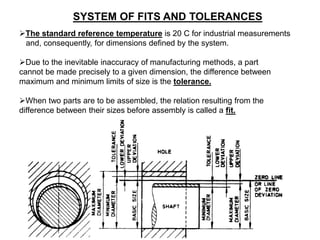
fits&tolerances OF ALL TYPES OF BEARINGS .ppt
- 1. SYSTEM OF FITS AND TOLERANCES The standard reference temperature is 20 C for industrial measurements and, consequently, for dimensions defined by the system. Due to the inevitable inaccuracy of manufacturing methods, a part cannot be made precisely to a given dimension, the difference between maximum and minimum limits of size is the tolerance. When two parts are to be assembled, the relation resulting from the difference between their sizes before assembly is called a fit.
- 2. Tolerance • How to decide tolerance? – Functional requirements of mating parts – Cost of production – Available manufacturing process • Choose as coarse tolerance as possible without compromising functional requirements • Proper balance between cost and quality of parts
- 3. Max Hole size – Basic Size = Upper Deviation Min Hole size – Basic Size = Lower Deviation HOLE Max shaft size – Basic Size = Upper Deviation Min shaft size – Basic Size = Lower Deviation SHAFT
- 4. CLEARANCE FIT Maximum shaft dimension < Minimum hole dimension FIT - condition of looseness or tightness between two mating parts being assembled together
- 5. INTERFERANCE FIT Maximum Hole size < Minimum Shaft size
- 6. TRANSITION FIT Obtained by overlapping of tolerance zones of shaft and hole ……Does not guarantee neither clearance nor interference fit
- 7. HOLE BASED SYSTEM- Size of hole is kept constant, shaft size is varied to get different fits. To obtain different types of fits, it is general practice to vary tolerance zone of one of the mating parts SHAFT BASED SYSTEM- Size of shaft is kept constant, hole size is varied to get different fits.
- 8. A fit is indicated by the basic size common to both components, followed by symbol corresponding to each component, the hole being quoted first. E.g. 45 H8/g7
- 9. H : lower deviation of hole is zero h : upper deviation of shaft is zero E.S. – upper deviation E.I. – lower deviation Representation of Tolerance 1) Letter Symbol The selection of letter freezes one limit of hole / shaft (how much away from Basic size) 45 E8/e7 Basic Size One can have different possible combinations; eg. 45H6g7, 45H8r6, 45E5p7
- 10. Representation of Tolerance 2) Number or Grade IT01, IT0, IT1,….IT16 Tolerance Grade defines range of dimensions (dimensional variation) There are manufacturing constraints on tolerance grade chosen
- 12. RANGE IN A GIVEN TOLERANCE GRADE
- 15. H : lower deviation of hole is zero Representation of Tolerance The selection of Tolerance grade number freezes the other limit of hole / shaft
- 16. Together (Letter & Grade) on both mating components decide quality of fit H7 : Tol Grade 7 mean 21μ variation (H means upper deviation zero) Representation of Fit 0.021 0.022 0.013 Φ30.000 Φ30.021 Φ30.022 Φ30.035 p6 : Tol Grade 6 means 13μ variation (p means upper deviation is 22 μ) INTERFERENCE FIT
- 19. Estimate kind of fit Φ30H7s6 Φ30H8e6 Φ30F8r6 Φ30G7r6
- 22. FITS AND TOLERANCES The components of the toleranced dimension shall be indicated in the following order: a) the basic size, and b) the tolerance symbol. If, in addition to the symbols it is necessary to express the values of the deviations or the limits of size, the additional information shall be shown in brackets. Permissible deviation •If a dimension needs to be limited in one direction only, this should be indicated by adding “min” or “max” to the dimension.
- 23. •The upper deviation or the upper limit of size shall be written in the upper position and the lower deviation or the lower limit of size in the lower position, irrespective of whether a hole or a shaft is toleranced. •The tolerance symbol for the hole shall be placed before that for the shaft or above it, the symbols being preceded by the basic size indicated once only. Indication of Tolerances on Angular Dimensions
- 29. STUFFING BOX